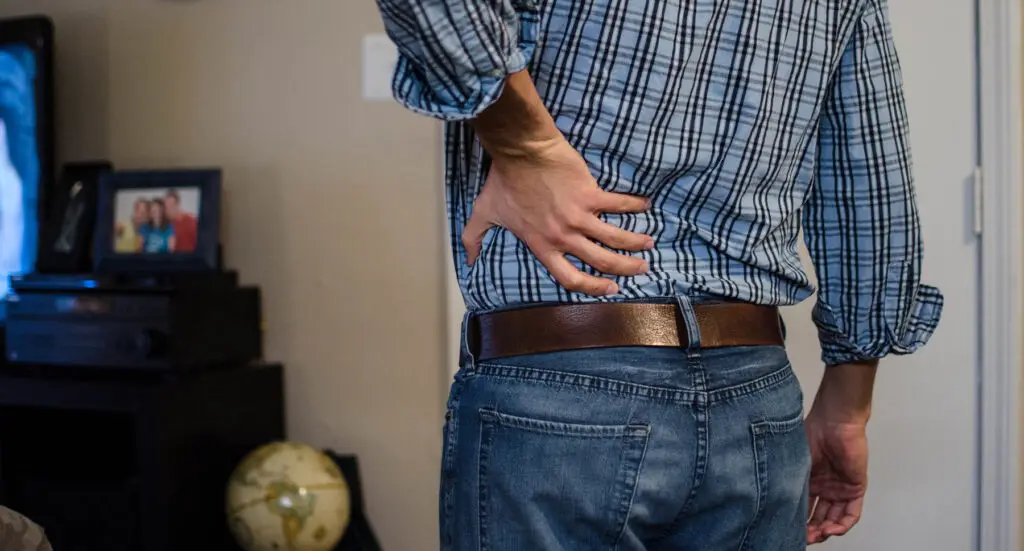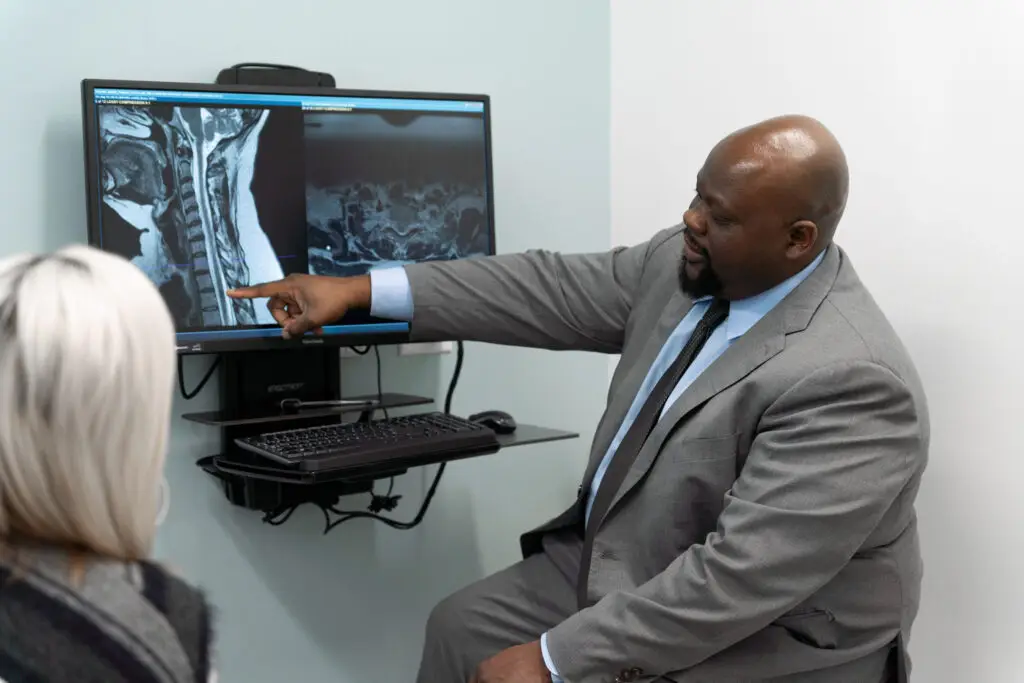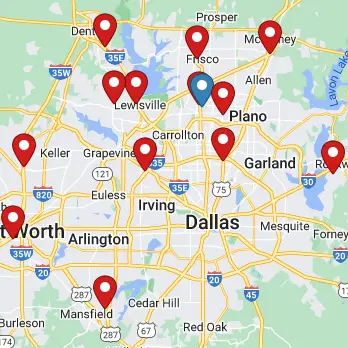What Is a Bulging Disc and How Is it Treated?
how we can help
An Overview
Since more than 3 million people each year in the US are diagnosed and treated for a herniated or bulging disc, there is a good possibility that you, or someone you know, has dealt with the discomfort and often relentless pain of this condition. These discs or cushions found between vertebrae in the spinal column withstand immense pressure from the activities of everyday life – walking, running, lifting, working, and hundreds of other simple tasks. However, later in life, this wear and tear will often catch up with many women and men.
As noted in the section of the Texas Back Institute website on herniated disks, “The vertebral column provides protection to the spinal cord that runs through its central cavity. Between each vertebra is an intervertebral disk. The disks are filled with a gelatinous substance, called the ‘nucleus pulposus,’ which provides cushioning to the spinal column. The annulus fibrosus is a fibrocartilaginous ring that surrounds the nucleus pulposus, which keeps the nucleus pulposus intact when forces are applied to the spinal column. The intervertebral disks allow the vertebral column to be flexible and function as ‘shock absorbers’ during everyday activities such as walking, running and jumping.”
Supported by the spine, the human body “machine” works great, humming along, until one of these disks is damaged. Then pain becomes a daily reminder of how important these shock absorbers really are.
Table of Contents
Symptoms
Diagnosing
Treatments
Patients Ask:
Can herniated disks heal on their own?
Texas Back Institute Responds: In most cases bulging disks get better on their own over time or with nonsurgical treatment for 9 out of 10 people.
What Causes a Bulging Disc?
In most cases, age-related wear and tear are the primary cause of a bulging disc. This is usually a gradual process of disc degeneration. With age, the disks become dehydrated, less flexible, and more prone to tearing or rupturing with even a minor strain or twist. Injuries associated with work or recreational activities can also cause a bulging disc. Something as simple as using the back muscles instead of the leg and thigh muscles to lift heavy objects can lead to a bulging disc. Twisting and turning while lifting also can also cause a bulging disk. In rare instances a traumatic event such as a fall or blow to the back can cause a bulging disc.
Spinal disk herniation, which is also referred to as a “slipped disk,” “ruptured disk” or more commonly as a “bulging disc,” occurs when the soft center of a spinal disk pushes through a crack in the tougher exterior casing. Most bulging discs occur in the low (lumbar spine region) back area and this condition is quite common and may or may not cause symptoms.
Even a healthy, well-hydrated disc can be injured. Stretching or tearing of the annulus may result in back or neck pain. The discs are immediately in front of the spinal cord and exiting nerves, so when the herniated disc or protrusion compresses the spinal cord or nerves, leg or arm pain and numbness or weakness may occur.
Patients Ask:
Is a herniated disc treated in the same way as a bulging disc?
Texas Back Institute Responds: Yes. The most common surgical treatment for a bulging or herniated disc is a discectomy. This is a minimally invasive procedure in which the spine surgery specialist removes the damaged part of the disc.
How Does a Bulging Disc Differ from a Herniated Disc?
Because of many similarities, the term herniated disc or disc herniation is often used interchangeably with bulging disc. This is understandable. Both conditions affect those “shock absorbers” or cushions that are found between the vertebrae and these discs show signs of wear and tear with age and become less flexible. And, in both cases these changes can cause the outer layer of the disk to bulge out.
Plus, just to make things even more confusing, a patient can have either a bulging disc or herniated disc without any symptoms. In some cases, a patient will find they have these disc changes only after having an imaging test, such as an MRI for another medical issue.
However, there is a difference between a bulging disc and a herniated disc.
The spine specialists at Texas Back note that a bulging disc does not always affect the entire disc. Usually, at least a quarter to a half of the disc’s circumference is affected. And only the outer layer of tough cartilage is involved.
A herniated disc, on the other hand, results when a crack in the tough outer layer of cartilage allows some of the softer inner cartilage to stick out of the disk. Herniated disks also are called “ruptured discs” or “slipped discs.” The whole disc does not rupture or slip. Only a small area of the crack is affected.
There is another difference between the two conditions. Specialists note that compared with a bulging disk, a herniated disk is more likely to cause pain. The inner cartilage of the disk sticks out farther and is more likely to irritate nerve roots. The irritation can be from pushing on the nerve or, much more commonly, the herniation causes a painful inflammation of the nerve root.

Patients Ask:
What does a bulging disc feel like?
Texas Back Institute Responds: Pain is often described as sharp or burning. Patients report feeling numbness or tingling. People who have bulging disks often have radiating numbness or tingling in the body part served by the affected nerves. Weakness is also experienced with this condition.
What Are the Symptoms of a Bulging Disk?
Patients who present with bulging disk symptoms can experience several issues. If this disk bulge occurs in the low back they often complain of back pain, leg pain, leg weakness, numbness, and, in some cases, difficulties with bowel and bladder usage.
A bulging disk in the neck, or cervical spine area, can cause neck pain, arm pain and arm weakness.
In some cases, a patient does not have obvious symptoms and is experiencing no pain, and the herniated disk is discovered when an MRI scan is completed while diagnosing a completely different condition. If there is no pain and the patient can continue with normal daily activities, we advise regular checkups to ensure the disk does not worsen.
On the other hand, in some cases, especially with a herniation in the cervical (neck) area, the disk herniation can be so large that it can cause compression of the spinal cord. These patients require more aggressive treatment.
For example, one of the most common locations for bulging disks is found in the C5-C6 spinal area. This disc bulge can result in weakness in the biceps muscles of the arms and the wrist extensor muscles as well as numbness and tingling along with pain that radiates to the thumb and fingertips.
How Are Bulging Discs Diagnosed?
The first step of this diagnostic process includes a physical examination. A neurological examination is also performed to identify the involved nerve root and assess the impact on spinal nerves. Because certain nerves consistently supply muscles and areas of sensation, physical examination and the patient’s specific symptoms give valuable clues to the source of the symptoms. The preferred imaging test is an MRI because it can visualize soft tissues including the disc, spinal fluid, and neural elements.
In a few cases, there are emergency indicators for a bulging disc and patients experiencing them should seek immediate medical attention. The most common symptoms are severe back and neck pain which can be worsened by sneezing, coughing, going to the toilet, or lifting heavy objects. Other symptoms include leg and arm pain, difficulty with bowel control, pain in the abdomen, chest, or stomach, and tingling or numbness in different areas of the body.

What Are the Treatment Options for a Bulging Disc?
With some patients, the spine specialists at Texas Back Institute recommend surgical procedures as the final option for bulging disc treatment. As such, the process of treatment begins with a very conservative approach with suggestions for over-the-counter medications and some behavior (restricting lifting and vigorous activities) modifications.
If this initial plan does not reduce the discomfort or pain from the disc bulge, the next step includes prescription-strength anti-inflammatory and muscle-relaxer medications along with pain medication and physical therapy to promote strength and range-of-motion in the back or neck, depending on where the herniation is located.
If this step does not alleviate the pain from the damaged disc, the next step would be to get an MRI scan to see where the bulging disc is located, how large it is and to assess its character. After this, some patients require spinal injections, which are a combination of local anesthetics and steroids which are delivered under X-ray guidance into the spinal canal. This will hopefully allow us to reduce the inflammation associated with the bulging disc.
A very small percentage of patients with a bulging or herniated disc will require surgery. This procedure is called a discectomy (link to procedure) and is used to decrease the pressure on the nerve by removing the disc fragment in the low back. It is minimally invasive to enable faster healing and recovery time for the patient.
In the neck area of the cervical spine, an approach in front of the spine requires removal of the entire disc and treatment may require replacing the disc or placing a bone graft to replace the space within the vertebral bodies to achieve fusion. In the thoracic (mid back) spine, options may include an approach from the back or the side of the chest to remove the fragment away from the spinal cord with or without a fusion.

Patients Ask:
Can exercise heal a bulging disc?
Texas Back Institute Responds: Exercise alone cannot heal a bulging disc. However, it can strengthen the back, increase spine stability, and help decrease stress on the disc. It is important to note that every back injury is different, so it is in your best interest to contact a medical professional such as one of the spine specialists at Texas Back Institute before participating in any strenuous exercise.
The Next Step
Managing the pain or recovering from a bulging disc is not only possible but occurs every day. For this to happen, spine specialists must be involved. When you are ready to be pain-free, take the next step. Click here to set an appointment with the experts at Texas Back Institute.
Learn more
Frequently Asked Questions
In most cases bulging disks get better on their own over time or with nonsurgical treatment for 9 out of 10 people.
Yes. The most common surgical treatment for a bulging or herniated disc is a discectomy. This is a minimally invasive procedure in which the spine surgery specialist removes the damaged part of the disc.
Pain is often described as sharp or burning. Patients report feeling numbness or tingling. People who have bulging disks often have radiating numbness or tingling in the body part served by the affected nerves. Weakness is also experienced with this condition.
Exercise alone cannot heal a bulging disc. However, it can strengthen the back, increase spine stability, and help decrease stress on the disc. It is important to note that every back injury is different, so it is in your best interest to contact a medical professional such as one of the spine specialists at Texas Back Institute before participating in any strenuous exercise.
Locations


